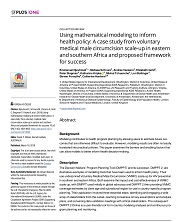Modeling contributes to health program planning by allowing users to estimate future outcomes that are otherwise difficult to evaluate. However, modeling results are often not easily translated into practical policies. This paper examines the barriers and enabling factors that can allow models to better inform health decision-making.
Through three iterations of the DMPPT applied to VMMC, a comprehensive framework with six steps was identified: (1) identify a champion, (2) engage stakeholders early and often, (3) encourage consensus, (4) customize analyses, (5), build capacity, and (6) establish a plan for sustainability. This framework could be successfully adapted to other HIV prevention programs to translate modeling results to policy and programming.
Models can be used to mobilize support, strategically plan, and monitor key programmatic elements, but they can also help inform policy environments in which programs are conceptualized and implemented to achieve results. The ways in which modeling has informed VMMC programs and policy may be applicable to an array of other health interventions.
Authors: Emmanuel Njeuhmeli, Melissa Schnure, Andrea Vazzano, Elizabeth Gold, Peter Stegman, Katharine Kripke, Michel Tchuenche, Lori Bollingerm Steven Forsythe, Catherine Hankins.


